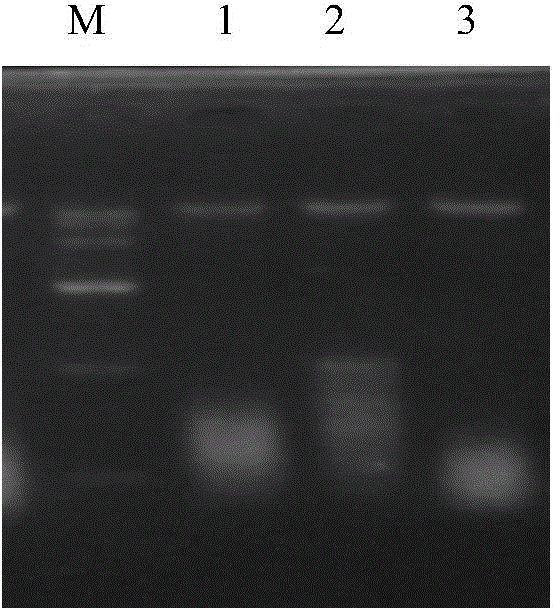Method for quickly extracting DNA from plant leaves
A technology of plant leaves and leaves, which is applied in the field of agricultural biotechnology and molecular biology, can solve the problems of many toxic chemical reagents, complex sample processing, and high reagent prices, and achieve low cost, simple sample processing, and good experimental results.
- Summary
- Abstract
- Description
- Claims
- Application Information
AI Technical Summary
Problems solved by technology
Method used
Image
Examples
specific Embodiment approach 1
[0019] Specific embodiment one: a kind of method for extracting DNA rapidly from plant leaf of the present embodiment, it is carried out according to the following steps:
[0020] 1. Take the plant leaves and place them in the centrifuge tube, and grind the leaves directly in the centrifuge tube;
[0021] 2. Add 5 to 8 times the volume of the leaf extracting buffer to the centrifuge tube after grinding the leaves in step 1 to obtain a leaf tissue mixture; treat it for 15 to 30 minutes at a water bath temperature of 55°C to 65°C, and then Add a separation liquid equal to the volume of the blade mixture, perform high-speed centrifugation, take the supernatant and add an equal volume of separation liquid, and then perform high-speed centrifugation; take the supernatant and add 2 / 3 volume of sedimentation liquid, and directly perform low-speed centrifugation to remove The supernatant collects the precipitate;
[0022] 3. The precipitate collected in step 2 is added to sterilized ...
specific Embodiment approach 2
[0027] Embodiment 2: This embodiment differs from Embodiment 1 in that the plant leaves described in Step 1 are derived from leaf tissue in growth stages and organ parts. Others are the same as in the first embodiment.
specific Embodiment approach 3
[0028] Embodiment 3: This embodiment differs from Embodiment 1 in that the leaf tissues in the growth stage and organ parts are the leaves in the vegetative growth stage, the leaves on the bolting flower branches or the top leaves of the massive roots in the reproductive growth stage. Others are the same as in the first embodiment.
PUM
 Login to View More
Login to View More Abstract
Description
Claims
Application Information
 Login to View More
Login to View More - R&D
- Intellectual Property
- Life Sciences
- Materials
- Tech Scout
- Unparalleled Data Quality
- Higher Quality Content
- 60% Fewer Hallucinations
Browse by: Latest US Patents, China's latest patents, Technical Efficacy Thesaurus, Application Domain, Technology Topic, Popular Technical Reports.
© 2025 PatSnap. All rights reserved.Legal|Privacy policy|Modern Slavery Act Transparency Statement|Sitemap|About US| Contact US: help@patsnap.com

